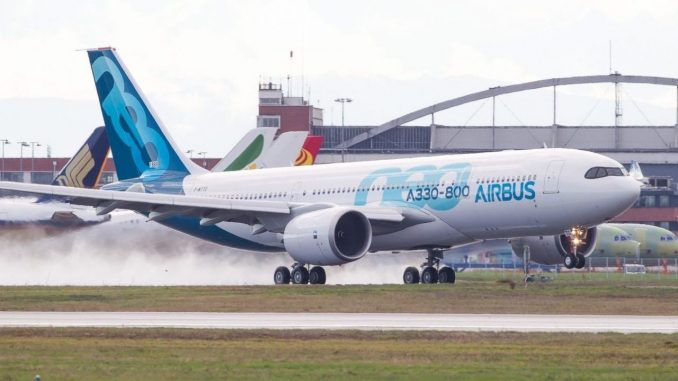
The second variant of the Airbus A330neo family, the -800 model, has flown for the first time today.
F-WTTO, the first A330-800neo (MSN1888), took off from Toulouse Airport at 1032 local time. The first flight tests the handling characteristics of both low and high speed flight, cabin pressurisation, flutter testing and landing configurations. First flights of new aircraft types typically last around four hours.
Airbus’ A330 family is the smallest wide body airliner produced by the European manufacturer. The new engine option (neo) model is offered in two variants, the -800 and -900. As the names suggest, the -800 is the smaller of the two, typically seating 257 passengers over a range of up to 15,094km / 8,150nmi. The Larger -900 seats around 287 passengers over a slightly reduced range of 13,334km / 7,200nmi.
The first -900 (MSN1795) flew on 19th October 2017, and the first production airframe, CS-TUA (MSN 1819) is due for imminent delivery to launch customer TAP Air Portugal. It was the third A330neo to be built, and has been performing route proving and cabin validation tests over the past months.
A tough sell
Airbus has historically struggled to sell its smallest aircraft variants, and the A330-800neo is no exception. After Hawaiian Airlines cancelled its order for six in favour of its closest rival, the Boeing 787 Dreamliner, there are only eight confirmed orders for the type. In October, Kuwait Airways ordered eight, which joins a memorandum of understanding from Uganda Airlines for two aircraft of this type.
The Airbus A340 (the A330’s four engined sister), saw a very similar state of affairs. Of the two original Airbus A340 models, the smaller -200 received just 28 orders. The slightly larger -300 received 218 orders and became the most prolific variant.
Potential delays
The Airbus A330neo is powered exclusively by the new Rolls-Royce Trent 7000 engine. In October this year, the British company announced that there are production delays with the new engine, which will therefore likely delay A330neo deliveries to customers. Engine delays are an ongoing problem in the industry, with both CFM and Pratt & Whitney delaying engine deliveries for the A320neo family due to technical issues. Rolls Royce also has technical issues with the Trent 1000, which powers the competing Boeing 787 Dreamliner, leaving many aircraft engineless at airports around the world.
Matt is a Berlin-based writer and reporter for International Flight Network. Originally from London, he has been involved in aviation from a very young age and has a particular focus on aircraft safety, accidents and technical details.



